详析英语倒装句的六种类型
- 格式:doc
- 大小:39.50 KB
- 文档页数:4
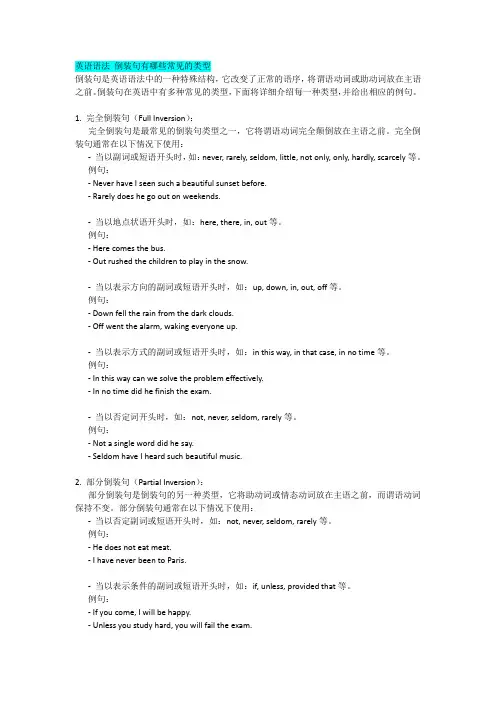
英语语法倒装句有哪些常见的类型倒装句是英语语法中的一种特殊结构,它改变了正常的语序,将谓语动词或助动词放在主语之前。
倒装句在英语中有多种常见的类型,下面将详细介绍每一种类型,并给出相应的例句。
1. 完全倒装句(Full Inversion):完全倒装句是最常见的倒装句类型之一,它将谓语动词完全颠倒放在主语之前。
完全倒装句通常在以下情况下使用:-当以副词或短语开头时,如:never, rarely, seldom, little, not only, only, hardly, scarcely等。
例句:- Never have I seen such a beautiful sunset before.- Rarely does he go out on weekends.-当以地点状语开头时,如:here, there, in, out等。
例句:- Here comes the bus.- Out rushed the children to play in the snow.-当以表示方向的副词或短语开头时,如:up, down, in, out, off等。
例句:- Down fell the rain from the dark clouds.- Off went the alarm, waking everyone up.-当以表示方式的副词或短语开头时,如:in this way, in that case, in no time等。
例句:- In this way can we solve the problem effectively.- In no time did he finish the exam.-当以否定词开头时,如:not, never, seldom, rarely等。
例句:- Not a single word did he say.- Seldom have I heard such beautiful music.2. 部分倒装句(Partial Inversion):部分倒装句是倒装句的另一种类型,它将助动词或情态动词放在主语之前,而谓语动词保持不变。
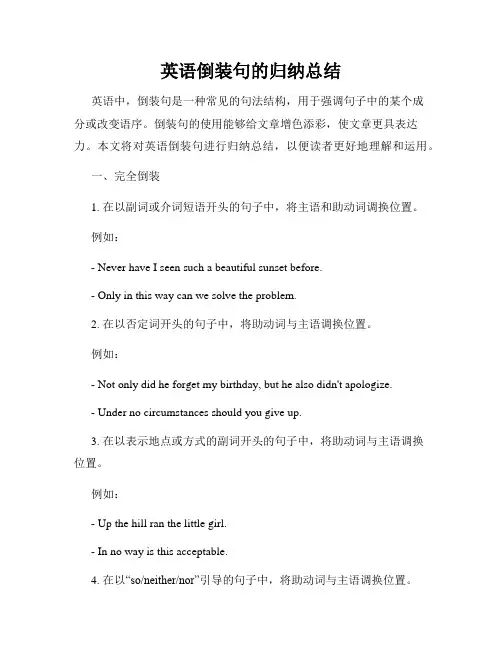
英语倒装句的归纳总结英语中,倒装句是一种常见的句法结构,用于强调句子中的某个成分或改变语序。
倒装句的使用能够给文章增色添彩,使文章更具表达力。
本文将对英语倒装句进行归纳总结,以便读者更好地理解和运用。
一、完全倒装1. 在以副词或介词短语开头的句子中,将主语和助动词调换位置。
例如:- Never have I seen such a beautiful sunset before.- Only in this way can we solve the problem.2. 在以否定词开头的句子中,将助动词与主语调换位置。
例如:- Not only did he forget my birthday, but he also didn't apologize.- Under no circumstances should you give up.3. 在以表示地点或方式的副词开头的句子中,将助动词与主语调换位置。
例如:- Up the hill ran the little girl.- In no way is this acceptable.4. 在以“so/neither/nor”引导的句子中,将助动词与主语调换位置。
例如:- So beautiful is the scenery that it takes my breath away.- Neither have I finished my homework, nor has my brother.二、部分倒装1. 在以“if/whether”引导的条件句中。
例如:- If you work hard, you will achieve your goals.- Whether he comes or not, we will have the party.2. 在以“so that/such that”引导的结果状语从句中。
例如:- He spoke so quickly that I couldn't catch up with him.- The problem is such that it requires a professional to solve it.3. 在以“as/though”引导的方式状语从句中。

高中英语倒装句详细分析_首先倒装可分为二种:将整个谓语提到主语之前的叫完全倒装;而只将be 、情态动词或者助动词放在主语之前的叫做部分倒装。
一、完全倒装1. There be结构。
另外,在此结构中可以用来代替be动词的动词有:exist, seem, happen, appear, live, rise, stand等。
如:There stood a dog before him.There exist different opinions on this question.2 (1).在以here、there、now、then等副词开头的句子里。
Here, There, Now, Then + come (或be,go,lie,run) + 主语结构。
Here comes the old lady!Then came the hour we had been looking forward to.注意:如果主语是人称代词,就不用倒装。
如:Here you are.There she comes.(2). 表示方向的副词out, in, up, down等置于句首,要用全部倒装。
如果主语是人称代词,就不用倒装。
如: In came Mr. White.Up went the arrow into the air.(3).当表示地点的介词词组(如on the wall, under the tree, in front of the house, in the middle of the room 等)在句首时。
At the foot of the hill lies a beautiful lake.The soldiers ran to the building, on the top of which flew a flag.3. 分词(代词) + be + 主语结构。
如:Walking at the head of the line was our teacher.Such was the story he told me.二、部分倒装部分倒装是把be动词、情态动词、助动词放到主语之前。
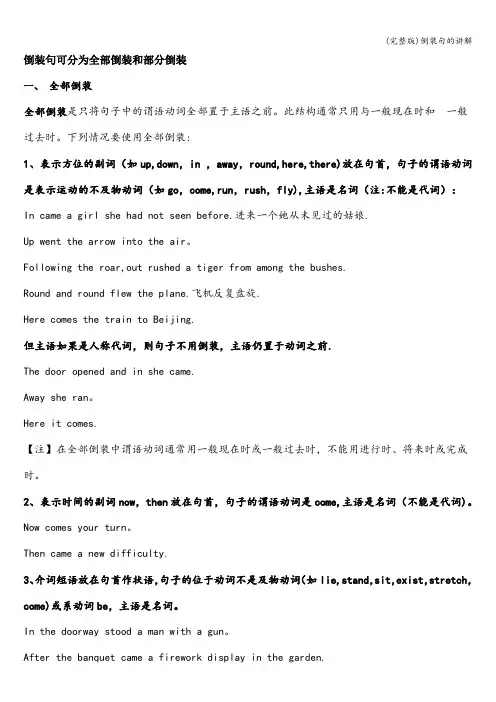
倒装句可分为全部倒装和部分倒装一、全部倒装全部倒装是只将句子中的谓语动词全部置于主语之前。
此结构通常只用与一般现在时和一般过去时。
下列情况要使用全部倒装:1、表示方位的副词(如up,down,in ,away,round,here,there)放在句首,句子的谓语动词是表示运动的不及物动词(如go,come,run,rush,fly),主语是名词(注:不能是代词):In came a girl she had not seen before.进来一个她从未见过的姑娘.Up went the arrow into the air。
Following the roar,out rushed a tiger from among the bushes.Round and round flew the plane.飞机反复盘旋.Here comes the train to Beijing.但主语如果是人称代词,则句子不用倒装,主语仍置于动词之前.The door opened and in she came.Away she ran。
Here it comes.【注】在全部倒装中谓语动词通常用一般现在时或一般过去时,不能用进行时、将来时或完成时。
2、表示时间的副词now,then放在句首,句子的谓语动词是come,主语是名词(不能是代词)。
Now comes your turn。
Then came a new difficulty.3、介词短语放在句首作状语,句子的位于动词不是及物动词(如lie,stand,sit,exist,stretch,come)或系动词be,主语是名词。
In the doorway stood a man with a gun。
After the banquet came a firework display in the garden.On the moon, as is known to all,exists no living thing。

倒装句的种类和用法倒装句是英语语法中一种常见的句子结构,它与一般肯定句的语序有所不同。
在倒装句中,动词通常出现在主语之前,或者助动词与主语之间发生位置调换。
倒装句在英语中的使用非常灵活,具有多种种类和用法。
本文将介绍倒装句的种类和用法。
一. 完全倒装句完全倒装句是最基本也是最常见的倒装句结构。
在完全倒装句中,助动词位于句首,动词跟在主语之后。
例如:1. Had I known the truth, I would not have gone.2. Not only did he pass the exam, but he also got the highest score.在示例1中,助动词"had"位于句首,动词"known"跟在主语"I"之后。
而在示例2中,副词短语"Not only"位于句首,助动词"did"位于副词短语之后,动词"pass"则跟在主语"he"之后。
二. 部分倒装句部分倒装句是通过将助动词或情态动词与主语之间的位置进行调换来构成的倒装句。
部分倒装句常用于以下几种情况:1. 否定副词或短语位于句首。
例如:Never have I seen such a beautiful sunset.2. 表示条件的状语从句位于句首。
例如:Should you need any further assistance, please do not hesitate to contact me.3. 表示地点或方向的状语位于句首。
例如:Up the hill ran the little girl.4. 存在“so + 形容词/副词 + 主语”结构时。
例如:So excited was she that she couldn't sleep.5. 在以“to + 动词原形”或“动词不定式短语”开头的句子中,为了强调动作发生在谁身上。
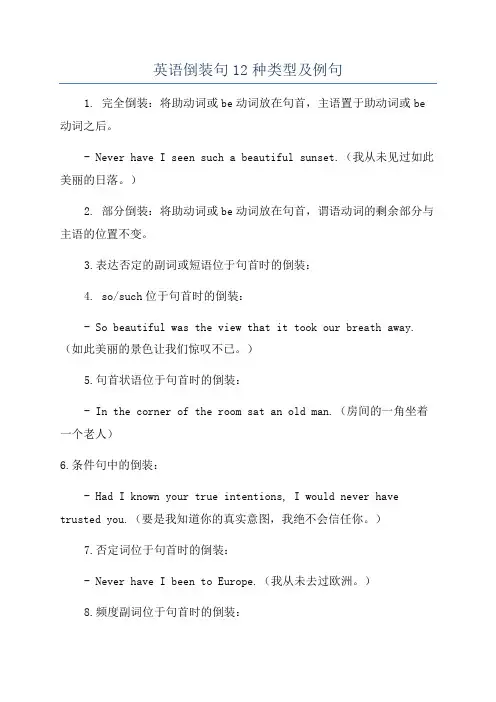
英语倒装句12种类型及例句1. 完全倒装:将助动词或be动词放在句首,主语置于助动词或be 动词之后。
- Never have I seen such a beautiful sunset.(我从未见过如此美丽的日落。
)2. 部分倒装:将助动词或be动词放在句首,谓语动词的剩余部分与主语的位置不变。
3.表达否定的副词或短语位于句首时的倒装:4. so/such位于句首时的倒装:- So beautiful was the view that it took our breath away.(如此美丽的景色让我们惊叹不已。
)5.句首状语位于句首时的倒装:- In the corner of the room sat an old man.(房间的一角坐着一个老人)6.条件句中的倒装:- Had I known your true intentions, I would never have trusted you.(要是我知道你的真实意图,我绝不会信任你。
)7.否定词位于句首时的倒装:- Never have I been to Europe.(我从未去过欧洲。
)8.频度副词位于句首时的倒装:- Rarely do we see such dedication.(我们很少见到如此的奉献精神。
)9.祈使句或祈使句部分的倒装:- Stand up!(站起来!)- Be quiet, please.(请安静。
)10. only位于句首时的倒装:- Only by working hard can you achieve your goals.(只有通过努力工作,你才能实现目标。
)11.地点状语置于句首时的倒装:- In the garden were beautiful flowers.(花园里有美丽的花朵。
)12.宾语置于句首时的倒装:- A love like this I have never felt before.(我之前从未感受过如此的爱。
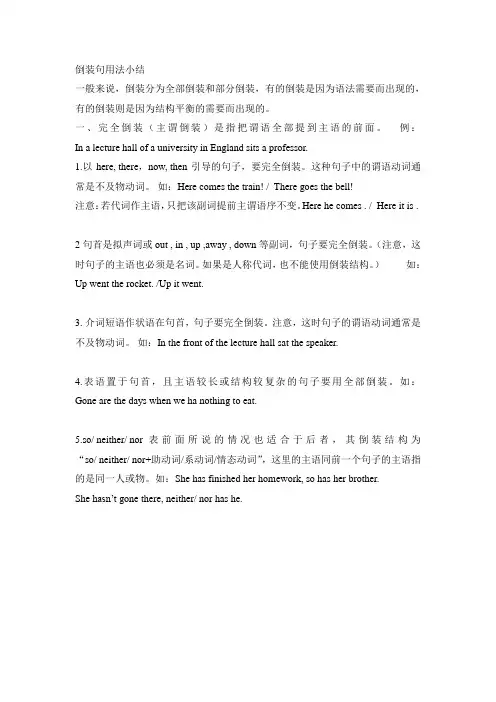
倒装句用法小结一般来说,倒装分为全部倒装和部分倒装,有的倒装是因为语法需要而出现的,有的倒装则是因为结构平衡的需要而出现的。
一、完全倒装(主谓倒装)是指把谓语全部提到主语的前面。
例:In a lecture hall of a university in England sits a professor.1.以here, there,now, then引导的句子,要完全倒装。
这种句子中的谓语动词通常是不及物动词。
如:Here comes the train! / There goes the bell!注意:若代词作主语,只把该副词提前主谓语序不变。
Here he comes . / Here it is .2句首是拟声词或 out , in , up ,away , down 等副词,句子要完全倒装。
(注意,这时句子的主语也必须是名词。
如果是人称代词,也不能使用倒装结构。
)如:Up went the rocket. /Up it went.3. 介词短语作状语在句首,句子要完全倒装。
注意,这时句子的谓语动词通常是不及物动词。
如:In the front of the lecture hall sat the speaker.4.表语置于句首,且主语较长或结构较复杂的句子要用全部倒装。
如:Gone are the days when we ha nothing to eat.5.so/ neither/ nor 表前面所说的情况也适合于后者,其倒装结构为“so/ neither/ nor+助动词/系动词/情态动词”,这里的主语同前一个句子的主语指的是同一人或物。
如:She has finished her homework, so has her brother.She hasn’t gone there, neither/ nor has he.二、部分倒装(助动词倒装)是指把谓语的一部分(助动词)提到主语的前面。
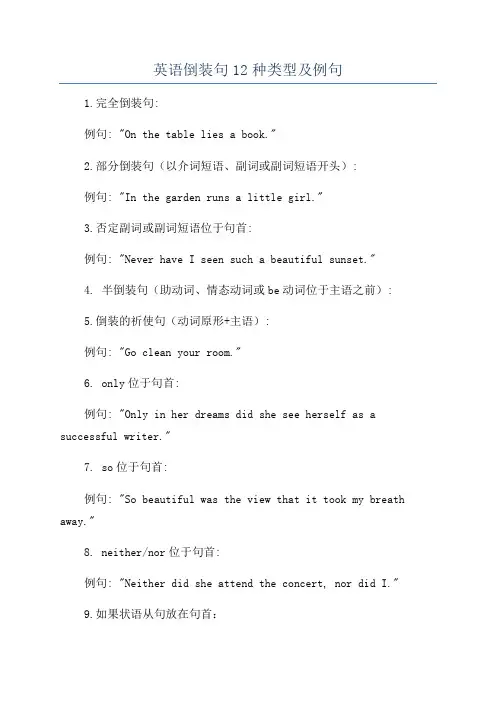
英语倒装句12种类型及例句1.完全倒装句:例句: "On the table lies a book."2.部分倒装句(以介词短语、副词或副词短语开头):例句: "In the garden runs a little girl."3.否定副词或副词短语位于句首:例句: "Never have I seen such a beautiful sunset."4. 半倒装句(助动词、情态动词或be动词位于主语之前):5.倒装的祈使句(动词原形+主语):例句: "Go clean your room."6. only位于句首:例句: "Only in her dreams did she see herself as a successful writer."7. so位于句首:例句: "So beautiful was the view that it took my breath away."8. neither/nor位于句首:例句: "Neither did she attend the concert, nor did I."9.如果状语从句放在句首:10.条件从句位于句首:例句: "Should he fail the exam, he will have to retake the course."11.介词短语或副词短语位于句首:例句: "In the corner sat a small dog."12. or/ nor引导的短语或句子位于句首:。
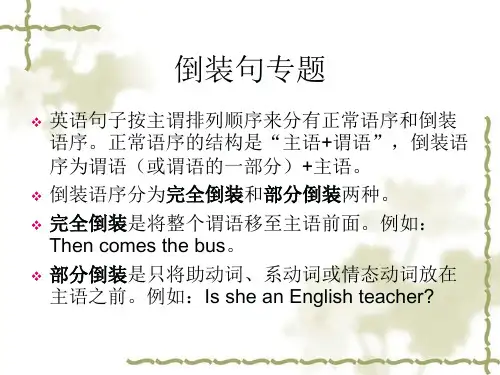
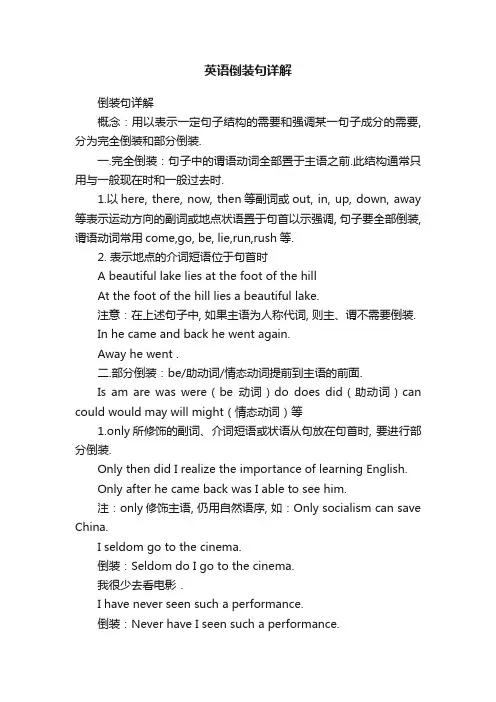
英语倒装句详解倒装句详解概念:用以表示一定句子结构的需要和强调某一句子成分的需要, 分为完全倒装和部分倒装.一.完全倒装:句子中的谓语动词全部置于主语之前.此结构通常只用与一般现在时和一般过去时.1.以here, there, now, then等副词或out, in, up, down, away 等表示运动方向的副词或地点状语置于句首以示强调, 句子要全部倒装, 谓语动词常用come,go, be, lie,run,rush等.2. 表示地点的介词短语位于句首时A beautiful lake lies at the foot of the hillAt the foot of the hill lies a beautiful lake.注意:在上述句子中, 如果主语为人称代词, 则主、谓不需要倒装.In he came and back he went again.Away he went .二.部分倒装:be/助动词/情态动词提前到主语的前面.Is am are was were(be动词)do does did(助动词)can could would may will might(情态动词)等1.only所修饰的副词、介词短语或状语从句放在句首时, 要进行部分倒装.Only then did I realize the importance of learning English.Only after he came back was I able to see him.注:only修饰主语, 仍用自然语序, 如:Only socialism can save China.I seldom go to the cinema.倒装:Seldom do I go to the cinema.我很少去看电影.I have never seen such a performance.倒装:Never have I seen such a performance.我从来没有看过这样的表演.2.否定副词及介词短语的否定词位于句首时.高考常考的这类词或词语有:never , not, seldom, hardly, little, nowhere, by no means, in no time等.3.not until 引导的从句位于句首引起的主句部分倒装He didn’t finish his homework until his mother came back.倒装:Not until his mother came back did he finish his homework.直到他的妈妈回来, 他才完成作业.The mother didn’t leave the room until the c hild fell asleep.倒装:Not until the child fell asleep did the mother leave the room.等到孩子睡着了, 妈妈才离开房间.注意:当Not until引出主从复合句, 主句倒装, 从句不倒装.4、as/ though (虽然, 尽管)引导的让步状语从句名词\形容词\副词\分词+as\though+主语+其他Although I am ugly, I am gentle.倒装:Ugly as I am, I am gentle.Though he is a child, he has to make a living.倒装:Child as he is, he has to make a living.注意:从句的表语是名词, 其名词前不加任何冠词5.用于so nor neither 开头的句子A、So +be/助动词/情态动词+主语某人也是如此Nor/neither +be/助动词/情态动词+主语某人也不是如此1). 他喜欢读书, 我也是.He likes reading very much. So do I .2). 我从来没有去过广州大学, 他也是.I have never been to Guangzhou University, neither/ nor hashe.Betty is a nice girl. So she isB、So +主语+be/助动词/情态动词某人确实如此6.在hardly/scarcely/…when;no sooner…than; not only … but also;so...that; such…that 的倒装句中, 前倒后不倒. hardly/scarcely/ no sooner后句子的谓语用had done, when/than 后句子的谓语用一般过去时(1) Hardly / Scarcely had he fallen asleep when a loud knock at the door awaked him.(2) No sooner had I reached the station than train moved.(3) Not only is he interested in football but also he plays it well.(4) So hard does he work that he has made great progress in English.7. If 虚拟条件从句中.从句有(were/should/had)1)If I were you, I would work hard. 倒装:Were I you, I would work hard.2) If it should rain tomorrow, we would put off our meeting.倒装: Should it rain tomorrow, we would put off our meeting.3)If he had followed my advice, he would have succeeded.倒装:Had he followed my advice, he would have succeeded.8.May置句首, 表示祝愿.May you succeed.祝你成功!补充知识1.全部倒装全部倒装是只将句子中的谓语动词全部置于主语之前.此结构通常只用于一般现在时和一般过去时.常见的结构有:1)here, there, now, then, thus等副词置于句首, 谓语动词常用be, come, go, lie, run等表示来去或状态的动词.Then came the chairman. 那时总裁来了.Here is your letter. 你的信.2)表示运动方向的副词或地点状语置于句首, 谓语表示运动的动词.Out rushed a missile from under the bomber. 轰炸机肚底下窜出一枚导弹.Ahead sat an old woman. 前面坐着一个老妪.注意:上述全部倒装的句型结构的主语必须是名词, 如果主语是人称代词则不能完全倒装.Here he comes. 他来了.Away they went. 他们走开了.2.部分倒装部分倒装是指将谓语的一部分如助动词或情态倒装至主语之前.如果句子的谓语没有助动词或情态动词, 则需添加助动词do, does或did, 并将其置于主语之前.1.句首为否定或半否定的词语, 如no, not, never, seldom, little, hardly, at no time决不, in no way, not until… 等. Never have I seen such a performance. 从未见过如此糟糕的表演.Nowhere will you find the answer to this question. 无论如何你不会找到这个问题的答案的.Not until the child fell asleep did the mother leave the room. 母亲一直到孩子入睡后离开房间.2.当Not until引出主从复合句, 主句倒装, 从句不倒装.注意:如否定词不在句首不倒装.I have never seen such a performance. ---never have I seen such a performance.The mother didn\'t leave the room until the child fell asleep.---not until the child fell asleep the mother did leave the room.改写为正常语序为, Man did not know what heat is until the early years of the 19th. 现在将not提前, 后面就不能再用否定了,否则意思就变了.3.以否定词开头作部分倒装如Not only…but also, Hardly/Scarcely…when, No sooner… than等, 要倒装.Not only did he refuse the gift, he also severely criticized the sender. 他没有收下礼物, 还狠狠批评了送礼的人. Hardly had she gone out when a student came to visit her. 她刚出门, 就有个学生来访.No sooner had she gone out than a student came to visit her. 她刚出门, 就有个学生来访.4. so, neither, nor作部分倒装用这些词表示\"也\"、\"也不\" 的句子要部分倒装.Tom can speak French. So can Jack. 汤姆会讲法语, 杰克也会.If you won\'t go, neither will I.你不去, 我也不去.注意:当so引出的句子用以对上文内容加以证实或肯定时, 不可用倒装结构.意为\"的确如此\".Tom asked me to go to play football and so I did. 汤姆邀我去踢球, 我去了.---It\'s raining hard.---So it is. 雨下得真大.是呀.5. only在句首倒装的情况.Only in this way, can you learn English well. 只有这样, 你才能学好英语.Only after being asked three times did he come to the meeting. 叫了三次, 他才来参加会议.如果句子为主从复合句, 则主句倒装, 从句不倒装.Only when he is seriously ill does he ever stay in bed. 病得狠重时, 他才卧床休息.6. as, though 引导的倒装句as / though引导的让步从句必须将表语或状语提前(形容词, 副词, 分词, 实义动词提前).但需注意:1)句首名词不能带任何冠词.2)句首是实义动词, 其他助动词放在主语后.如果实义动词有宾语和状语, 随实义动词一起放在主语之前.Try hard as he will, he never seems able to do the work satisfactorily. 他工作很努力, 但总不能让人满意.注意:让步状语从句中, 有though, although时, 后面的主句不能有but, 但是though 和yet可连用.7. 其他部分倒装1)so… that 句型中的so 位于句首时, 需倒装.So frightened was he that he did not dare to move an inch. 他害怕得很, 动也不敢动.2)在某些表示祝愿的句型中.例如:May you all be happy. 愿你们都快乐.3)在虚拟语气条件句中从句谓语动词有were, had, should等词, 可将if 省略, 把were, had, should 移到主语之前, 采取部分倒装.例如:Were I you, I would try it again. 我是你的话, 就再试一次.深化拓展一、全倒装:五全=有时表地方经常与be/come/exist/fall/follow/go/remain/seem/stand(表示移动或动态的不及物动词连用)或用表示类似存在观念的其他不及物动词如:live, stand, come, lie, flow, enter, rise 和appear等1、有:在there be结构里There is a box on the table.桌子上面有一个盒子.2、时:表示时间副词, 如:now, then,Now comes your turn.现在轮到你了.3、表:表语放句子前,表语+系动词+主语的结构Present at the party were Mr. Green and many other guests.格林先生和其他的客人在这个聚会上.Seated on the ground are a group of young men.一群年轻人坐在了地上.4、地:地点状语放在句首In south of the river lies a small factory. 小工厂位于河的南方.From the valley came a cry.山谷传来一阵哭声.5、方:表方位的副词here, there 或out, in, up, down, away, off等标志词放在句首There lies a large wheat field in front of the house.房子前面有一大片麦田.Off all the lights went when I came in.当我进来时, 所有的灯都灭了.二、半倒装:八部=不只让步也常需(虚)如此祝福1、不表示否定①no,not, never, hardly, no,not,never,hardly,barely,seldom,rarely,scarcely,nolonger,nowhere Never have I been to Beijing.我从没有没有去过北京.②绝不:at n time, in no way, by no means, on no account, in no case, in/under no circumstance At no time can we give up.我们决不能放弃.③Not until ...:直到Not until my mother came home did I go to bed.知道我妈妈回家我才睡觉.④Hardly/ Scarcely...(过完)...when...(一过)...:一...就...No sooner...(过完)...than...(一过)...:一...就...He had hardly got home when it happened to rain.=Had he hardly got home when it happened to rain.他一到家碰巧就下雨了.⑤Not only......but also......:(前倒后不倒)Not only did he refuse the gift, he also severely criticized the sender.他没有收下礼物, 还狠狠批评了送礼的人2、只:only所修饰的副词、介词短语或状语从句放在句子开头时.Only then did I realize that I was wrong.只有到那时我才意识到我错了.Only in this way can you learn from your mistake.只有用这样的方法你可以从错误中学习.Only when the war was over in 1918 was he able to get happily back to work.只有当战争于1918年结束时候, 他才能够快乐地回到工作当中.※当only 之后所接的不是状语时不可以用倒装Only Comrade Zhang knows about the matter..只有张同志知道这件事.3、让步:as/though/although引导让步状语从句时要倒装(形/副/名/动+as +主语+ 谓语)Proud as they are, they are afraid to see me.尽管他们自豪, 但是他们还怕见到我.Child as he is, he seems to know everything.(child前不加冠词)尽管他是个孩子, 但他好像知道一切.Hard as he worded, he made little progress.尽管他努力工作, 但是几乎没什么进步.※以上句中as可以替换though/although, 但是as更加常用.4、也:so/nor/neither开头,表示谓语所述的情况也适用于另一个人或一事物的肯定或否定句so用于肯定句, 表示也一样也这样;nor/neither用于否定句, 表示同样也不, 也不这样.I am watching TV. So is she.我正在看电视, 她也在看.My parents didn't watch TV last night. Neither (Nor)did I.我父母昨晚没有看电视, 我也没有看.※表示两人的同样一个情况时, 只能表示一件事, 即上、下句所使用的动词、时态要一致.5、常:表示频度副词如:often、many a time, now and again 等经常用于正式的文体中Often did he advise them not to smoke.他经常建议他们不要抽烟.6、需=虚拟:省略if的虚拟条件句, 把助动词were、had、should提到主语前面时Had it not been for your help, we shouldn't have achieved so much.要不是你的帮助, 我们不可能收获这么多.7、如此:so/such …that….从句中, 当so+形容词/副词或such+名词位于句首时.So exhausted was she that she wanted to have a rest.他是如此地疲惫以至于想要休息一下.8、祝福:当may放在句首, 表达祝愿时.May you succeed! 祝你成功!。

倒装句七种英语结构
倒装句是英语语法中的一种特殊结构,常用于强调或表达语气的变化。
以下是七种常见的倒装句结构:
1. 完全倒装:主语与谓语的位置颠倒。
例如:Never have I seen such a beautiful sunset.
2. 部分倒装:将助动词或情态动词与主语的位置颠倒。
例如:Not only does he play basketball well, but he also excels in football.
3. 前置式倒装:将表示地点、时间、方向等的副词或短语放在句首并与谓语的位置颠倒。
例如:In the middle of the room stood
a big table.
4. 介词短语倒装:在表示地点、时间、原因等的介词短语前使用倒装结构。
例如:Under no circumstances should you give up your dream.
5. 句首副词倒装:将表示否定、频率、程度等的副词置于句首并与谓语的位置颠倒。
例如:Seldom have I seen such a beautiful painting.
6. 祈使句倒装:用于祈使句中,将动词与主语位置颠倒。
例如:Never mind, let's try again.
7. 条件句倒装:在条件句中,将“if”与主语的位置颠倒。
例如:Had I known the truth, I would not have gone there.
以上是七种常见的倒装句结构,掌握它们能够更加灵活地运用英
语语法,使语言表达更加生动有力。
英语倒装句的用法归纳总结
英语倒装句是指把谓语动词或助动词放在主语之前的句型结构。
它通常用于强调句子中的某一部分,或者在特定的语法情况下使用。
下面我将对英语倒装句的用法进行归纳总结:
1. 全部倒装,在句首将整个谓语动词短语倒装,主要用于表示
强调或者表示条件。
例如,Only then did I realize the importance of the decision.
2. 部分倒装,将助动词、情态动词或者连词后面的主语和谓语
动词倒装,主要用于表示否定、半否定、以及表示方向性的副词短语。
例如,Not only did he finish the project on time, but
he also exceeded our expectations.
3. 倒装疑问句,在一般疑问句中,助动词或情态动词与主语倒装。
例如,Can you swim?
4. 倒装条件句,在以"should", "had", "were"开头的条件句中,主句的谓语动词和主语倒装。
例如,Had I known about the meeting, I would have attended.
5. 倒装句型用于表示方向性的副词短语,如,Here comes the bus.
总的来说,英语倒装句的使用有一定的规律,主要用于强调、
条件句、疑问句和特定的副词短语。
在写作和口语表达中,合适地
运用倒装句可以使语言更加生动有力。
希望以上总结对你有所帮助。
英语倒装句讲解倒装句分为全部倒装和部分倒装一.倒装句之全部倒装全部倒装是只将句子中的谓语动词全部置于主语之前。
此结构通常只用于一般现在时和一般过去时。
常见的结构有:1)here, there, now, then, thus等副词置于句首, 谓语动词常用be, come, go, lie, run等表示来去或状态的动词。
例如:Then came the chairman. 那时总裁来了。
Here is your letter. 你的信。
2)表示运动方向的副词或地点状语置于句首,谓语表示运动的动词。
例如:Out rushed a missile from under the bomber. 轰炸机肚底下窜出一枚导弹。
Ahead sat an old woman. 前面坐着一个老妪。
3) 在there be或者there live(stand, appear, seem, remain, exist….) 句型中。
例如:There are thousands of people on the square.There lived an old fisherman in the village.There stands a little girl.4)在某些表示祝愿的句型中。
例如:Long live the People's Republic of China! 中华人民共和国万岁!May you all be happy. 愿你们都快乐。
注意:上述全部倒装的句型结构的主语必须是名词,如果主语是人称代词则不能完全倒装。
例如:Here you are.Here he comes. 他来了。
Away they went. 他们走开了。
二.倒装句之部分倒装部分倒装是指将谓语的一部分如助动词或情态倒装至主语之前。
如果句子的谓语没有助动词或情态动词,则需添加助动词do, does或did,并将其置于主语之前。
倒装句的种类及常见句型倒装句是英语中常见的一种语法结构,它与普通的句式结构不同,通常会将主语和谓语的顺序颠倒。
倒装句在表达强调、对比、条件等意义时具有独特的作用,同时也是考试和日常写作中需要掌握的重要语法知识。
本文将介绍倒装句的种类及常见句型。
一、完全倒装句完全倒装句在句子中把整个谓语都移至主语之前,常见的结构有以下几种:1. 在助动词或情态动词之前倒装:Never had I seen such a beautiful sunset before.(我以前从未见过如此美丽的日落。
)Not only does she speak English fluently, but she also speaks French.(她不仅英语讲得流利,而且还会说法语。
)2. 在表示方位、地点或副词(adverbs of place)之前倒装:Out rushed the students as soon as the bell rang.(铃一响,学生们都冲了出去。
)Here comes the bus.(车来了。
)3. 在表示条件和让步的状语从句之前倒装:Should you have any questions, please feel free to ask.(如果你有任何问题,请随时提问。
)However hard he worked, he couldn't pass the exam.(无论他多努力,他都无法通过考试。
)二、部分倒装句部分倒装句是指将谓语的一部分与主语颠倒,常见的结构有以下几种:1. 在否定副词或短语之前倒装:Not until midnight did the party finally come to an end.(直到午夜,聚会才最终结束。
)At no time did she mention his name.(她从不提他的名字。
)2. 在连词so、neither、nor等之后倒装:They were tired, and so were we.(他们累了,我们也是。
英语语法结构--倒装句倒装句是英语语法中的一种结构,指的是将句子中的主语和谓语的位置颠倒,即将谓语置于主语之前。
倒装句在英语中使用频率较高,常用于强调、表示条件、表示地点和时间等情况下。
以下是关于倒装句的详细介绍。
一、完全倒装句完全倒装句是指将整个谓语放在主语之前,常见的结构有:1."助动词/情态动词 + 主语 + 谓语" 例如:•Can you swim? (你会游泳吗?)•Will she come tomorrow? (她明天会来吗?)•Should we start now? (我们现在应该开始吗?)•Had I known the truth, I wouldn't have gone. (如果我知道真相,我就不会走了。
)2."状语 + 动词 + 主语" 例如:•In came the teacher. (老师走了进来。
)•Out rushed the students. (学生们冲了出去。
)•Up went the balloon. (气球飘了上去。
)•Down fell the rain. (雨下了下来。
)3."there be" 结构的倒装例如:•There is a book on the desk. (桌子上有一本书。
)•There are many people in the park. (公园里有很多人。
)•There was a loud noise outside. (外面传来一声巨响。
)•There will be a meeting next week. (下周将有一次会议。
)二、部分倒装句部分倒装句是指将谓语中的助动词或情态动词放在主语之前,常见的结构有:1."助动词/情态动词 + 主语 + 不完全动词" 例如:•Did you see the movie? (你看过那部电影吗?)•Does she like ice cream? (她喜欢冰淇淋吗?)•Can I borrow your pen? (我可以借你的笔吗?)•Should we go now? (我们现在应该走吗?)2."情态动词 + 主语 + 动词" 例如:•Can you swim? (你会游泳吗?)•Will she come tomorrow? (她明天会来吗?)•Must he finish the report today? (他必须今天完成报告吗?)•Should we start now? (我们现在应该开始吗?)3."副词 + 助动词/情态动词 + 主语 + 动词" 例如:•Never have I seen such a beautiful sunset. (我从未见过如此美丽的日落。
倒装句的几种类型倒装句是指将句子中的主语和谓语动词的位置进行颠倒的句子结构。
根据倒装的形式和用途,倒装句可分为以下几种类型:1.全部倒装:句子的谓语动词位于主语之前。
例:In the classroom sat a group of students.(教室里坐着一群学生。
)2. 部分倒装:句子中只有助动词、情态动词或be动词位于主语之前。
例:Never have I seen such a beautiful sunset.(我从未见过如此美丽的日落。
)3.地点状语倒装:表示地点的状语位于句首时,常常使用倒装结构。
例:On the top of the mountain stood a small cabin.(山顶上矗立着一间小木屋。
)4.否定副词位于句首的倒装:表示否定意义的副词位于句首时,常常使用倒装结构。
例:Not only did he finish his homework, but he also cleaned the house.(他不仅完成了作业,还打扫了房间。
)5. so/such引导的倒装:so/such位于句首引导结果状语时,常常使用倒装结构。
例:So hot was the weather that we couldn't go outside.(天气太热,我们无法出门。
)6.祈使句倒装:用于表示请求、建议、命令等的祈使句常常使用倒装。
例:Turn off the lights, please.(请关灯。
)请注意,不同的语境和语法结构可能会产生不同的倒装现象,以上只列举了一些常见的倒装句类型。
英语倒装句的归纳总结《英语倒装句》倒装句是英语中常见的语法结构,它通过将谓语动词或助动词放在主语之前,以改变句子的语序。
倒装句在不同语境下有不同的应用,它可以使句子更加强调,或者用于疑问句、条件句等特殊情况。
下面对英语倒装句进行归纳总结。
一、全部倒装1. 在以否定词开头的句子中,把助动词或情态动词提到主语之前。
- Not only did he pass the exam, but he also got the highest score.(不仅他通过了考试,而且他还得了最高分。
)- Never have I seen such a beautiful sunset.(我从未见过如此美丽的日落。
)2. 在表示方向的介词短语之前,把助动词或情态动词提到主语之前。
- Up went the balloon into the sky.(气球升上了天空。
)- Out rushed the children when the school bell rang.(学校铃声一响,孩子们冲了出去。
)二、部分倒装1. 在以否定副词或副词短语开头的句子中,把助动词或情态动词提到主语之前。
- Hardly had I entered the room when the phone rang.(我一进屋就电话响了。
)- Nor did he mention anything about the incident during the meeting.(在会议期间,他也没有提到这个事件。
)2. 在表示条件的状语从句中,把助动词或情态动词提到主语之前。
- Should you need any assistance, please do not hesitate to contact us.(如果你需要任何帮助,请随时与我们联系。
)- Were he to find out the truth, he would be devastated.(如果他发现真相,他会崩溃的。
详析英语倒装句的六种类型
英语句子使用的目的,可分为四大类:陈述句、疑问句、祈使句和感叹句。
这四大类型句子都有可能出现倒装句。
倒装句分为全倒装和部分倒装两种类型。
浅析如下:
一、疑问句中出现的倒装句
1. 特殊疑问句中
(1)What is this?(全倒装)这是什么?
(2)Which do you want?(部分倒装)你想要哪一件?+
2. 一般疑问句
(1)Do you study English every day?(部分倒装)你每天学习英语吗?
(2)May I come in? 我能进来吗?
(3)Are you going to be a teacher? 你打算做一名老师吗?
【注意】:
1.特殊疑问句中,如果疑问词做主语或疑问词修饰主语时,句子不用倒装,即用陈述语序。
例如:Who did it yesterday? Which guy can do this work?
2.一般疑问句中,常把助动词或情态动词放在句首,即位于主语前,而构成部分倒装。
二、感叹句中出现倒装句
1. What引导的感叹句
(1)What a happy life we have had!(宾语在主语前面) 我们过着多么幸福的生活啊!
(2)What a fine day it is!(表语在主语前面)今天的天气多好啊!
(3)What a shining example Comrade Lei Feng has set us! 雷锋同志给我们树了多好的榜样啊!
2. How引导的感叹句
(1)How happy we are!(表语在前面)我们多么高兴啊!
(2)How hard they are working!(状语在前面)他们工作地多么努力啊!
(3)How nice a day it is! 多么好的天气啊!
3. 副词引导词引导的感叹句
(1)There comes the bus! 汽车来了!
(2)In come the students! 学生进来了!
(3)Off goes the worker! 工人下车了!
【注意】:
1. What或how 引导的句子,主谓也有不倒装的。
2. What所强调的重点是名词,这一名词一般是表语或宾语,有时所强调的名词可能是主语。
例如:What enormous crowd came! What也可单独使用。
例句:What she suffered in the old days!
3. How修饰形容词、副词或动词。
有时how many的搭配也可修饰名词。
For how many years have I waited! 该短语作状语。
4. 副词引导词位于句首,一方面为了强调,另一方面使情景生动。
主语是名词时,主谓倒装;如果主语是人称代词,主谓不倒装。
例如:Away he went to the station!
三、祈使句中出现的倒装
1. Long live the king! 国王万岁!
2. Long live the People’s Republic of China! 中华人民共和国万岁!
3. May you succeed! 祝你成功!
Long may he live! 愿他长命百岁!
4. Don’t you open the door. Don’t anyone open the door.
你不要开门!任何人不准开门!
【注意】:
祈使句一般无主语,有时也有主语出现。
祈使句的主语要重读,代词也要重读(陈述句的主语一般不重读)。
祈使句常用句号。
表示一种强烈感情时,句子用感叹号。
如:
四、陈述句中出现的几种倒装句
1. 主谓倒装
(1)Long long ago, there was a war between the birds and the beasts.
从前,鸟类和兽类之间有一场战争。
(2)Once upon a time there were six blind men in India.
从前,六个盲人住在印度。
(3)“Come along, then.”said the bird.鸟说:“那么请过来。
”
2. 表语倒装
(1)Such was Albert Einstein,a simple man of great achievements.(全倒装句)
(2)Inside the pyramids are the rooms for the bodies of kings and queens.
金字塔里面的房间是给国王和王后的。
(3)A very reliable person he is.(主语是人称代词时,主谓不倒装)
他是一个相当可靠的人。
3. 宾语倒装
(1)Many happy hours she had spent planning for something nice for him.
(2)Twenty-one dollars they took for it.他们要了21美元。
(3)Not a single mistake did he make. 他一个错误也没有犯。
(4)Only a dictionary he never forgets to bring here.
他从来不会忘记把一本字典带到这里。
【注意】:
宾语在前时,多数属于强调部分,句子一般不加助动词,偶尔也有助动词出现,如例句(3)。
五、复合句中的倒装
(1)I take back what I said. 我收回我说的话。
(2)...and the ship would have sunk with all board had it not been for the captain.
要是没有那位船长,就会连船带人都沉没了。
(3)Were I you,I would go with him.如果我是你,我就跟他走了。
(4)Proud as these nobles are,he is afraid to see me.同贵族一样高傲,他不想见我。
(5)Not only was everything that he had taken away from him,but also his German citizenship.
他们不仅拿走了他所有的东西;而且取消了的德国公民身份。
(6)Hardly (Scarcely)had he sat down when the telephone rang.他还没有做下,电话就响了。
(7)The harder you work, the greater will be your achievement.你越努力,你就收获越多。
六、其他倒装
陈述句中为了保持句子平衡或为了强调表语、宾语、状语等成分,或使上下文紧密衔接时,使用倒装句。
(1)On the wall is a blackboard on which were written some words,“It is no use sitting here without listening to me.”(定语从句中,主语的同位语太长)
墙上的黑板上写着一句话:“(你们)只是坐着而不听我(说话)是没有用的。
”
(2)They entered the classroom,in front of which sat a naughty boy.(使上下文紧密衔接)他们走进了教室,教室前面坐着一个淘气的男孩。
(3)Gone forever are the days when the Chinese people were looked down upon by the foreigners.(主语加上定语后太长而表语短,所以表语在前面,强调句子平衡)中国人被外国人瞧不起的日子永远过去了。